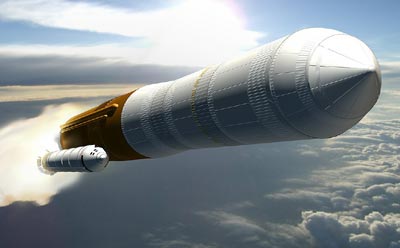
BALTIMORE — Mario Livio tossed his car keys in the air.
They rose ever more slowly, paused, shining, at the top of their arc, and then in accordance with everything our Galilean ape brains have ever learned to expect, crashed back down into his hand.
That was the whole problem, explained Dr. Livio, a theorist at the Space Telescope Science Institute here on the Johns Hopkins campus.
A decade ago, astronomers discovered that what is true for your car keys is not true for the galaxies. Having been impelled apart by the force of the Big Bang, the galaxies, in defiance of cosmic gravity, are picking up speed on a dash toward eternity. If they were keys, they would be shooting for the ceiling.
“That is how shocking this was,” Dr. Livio said.
It is still shocking. Although cosmologists have adopted a cute name, dark energy, for whatever is driving this apparently antigravitational behavior on the part of the universe, nobody claims to understand why it is happening, or its implications for the future of the universe and of the life within it, despite thousands of learned papers, scores of conferences and millions of dollars’ worth of telescope time. It has led some cosmologists to the verge of abandoning their fondest dream: a theory that can account for the universe and everything about it in a single breath.
“The discovery of dark energy has greatly changed how we think about the laws of nature,” said Edward Witten, a theorist at the Institute for Advanced Study in Princeton, N.J.
This fall, NASA and the Department of Energy plan to invite proposals for a $600 million satellite mission devoted to dark energy. But some scientists fear that might not be enough. When astronomers and physicists gathered at the Space Telescope Science Institute recently to take stock of the revolution, their despair of getting to the bottom of the dark energy mystery anytime soon, if ever, was palpable, even as they anticipate a flood of new data from the sky in coming years. When it came time for one physicist to discuss new ideas about dark energy, he showed a blank screen.
The institute’s director, Matt Mountain, said that dark energy had given this generation of astronomers a rare opportunity, and he admonished them to use it wisely.
“We are placing a large bet,” Dr. Mountain said, “using our credibility as collateral, that we as a community know what we are doing.”
But many stressed that it was going to be a long march with no clear end in sight. Lawrence Krauss of Case Western Reserve University told them, “In spite of the fact that you are liable to spend the rest of your lives measuring stuff that won’t tell us what we want to know, you should keep doing it.”
Scuffling in the Dark
Through myriad techniques and observations, cosmologists have recently arrived, after decades of strife, at a robust but dark consensus regarding a cosmos in which stars and galaxies, as well as the humans who gawk at them, amount to barely more than a disputatious froth. It was born 13.7 billion years ago in the Big Bang. By weight it is 4 percent atoms and 22 percent so-called dark matter of unknown identity — perhaps elementary particles that will be discovered at the Large Hadron Collider starting up outside Geneva this year. That leaves 74 percent for the weight of whatever began causing the cosmos to accelerate about five billion years ago.
As far as astronomers can tell, there is no relation between dark matter, the particles, and dark energy other than the name, but you never know. Some physicists are even willing to burn down their old sainted Einstein and revise his theory of gravity, general relativity, to make the cosmic discrepancies go away. There is in fact a simple explanation for the dark energy, Dr. Witten pointed out, one whose tangled history goes all the way back to Einstein, but it is also the most troubling.
“Dark energy has the somewhat unusual property that it was embarrassing before it was discovered,” he said.
In 1917, Einstein invented a fudge factor known as the cosmological constant, a sort of cosmic repulsion to balance gravity and keep the universe in balance. He abandoned his constant when the universe was discovered to be expanding, but quantum physics resurrected it by showing that empty space should be foaming with energy that had the properties of Einstein’s constant.
Alas, all attempts to calculate the amount of this energy come up with an unrealistically huge number, enough energy to blow away the contents of the cosmos like leaves in a storm before stars or galaxies could form. Nothing could live there.
Dr. Witten and other physicists used to think this conundrum “would somehow go away.” Something was missing in physicists’ understanding of physics, the logic went. The constant was really zero for deep reasons that, when revealed, would lead physicists closer to an understanding of what they call “the vacuum,” that is to say, the structure of reality.
“It seems now that the answer is not really zero,” Dr. Witten said.
Requiem for a Dream
Einstein’s constant is the most economical explanation for dark energy, Dr. Witten said. The others, involving new force fields or tinkering with Einstein’s gravity, are hard to make work and raise more questions than they answer. But if dark energy is the cosmological constant, it is smaller than predicted by a shocking factor of 1060. No fundamental principles can explain why Einstein’s constant, or any physical parameter, could be so small without being zero, Dr. Witten said. Zero can be a fundamental number, he said, but not a 1 with 59 zeroes between it and the decimal point.
As a result, he said, maybe physicists should give up trying to explain that number and look instead for a theory that generates all kinds of universes, a so-called multiverse.
That idea has been given mathematical form by string theory, which portrays the constituents of nature as tiny wriggling strings, an elegant idea that in principle explains all the forces of nature but in practice leads to at least 10500 potential universes.
This maze was an embarrassment for string theory. As Dr. Witten, one of the leaders of the field, said, “I am tempted to say this was an embarrassment of my youth.”
“Who needs that mess?” he recalled thinking. “There is just one world we live in.”
Now, Dr. Witten allowed, dark energy might have transformed this fecundity from a vice into a virtue, a way to generate universes where you can find any cosmological constant you want. We just live in one where life is possible, just as fish only live in water.
“This interpretation of string theory might be close to the truth,” Dr. Witten said. But that truth comes at a cost.
“Before the discovery of the dark energy, quantum physicists tended to assume that the ‘vacuum’ we live in has some deep meaning that reflects nature’s deepest secrets,” Dr. Witten said. But if ours is only one of a zillion in a haystack, there is nothing special about it, no secret to be found.
It could still turn out that dark energy is some as-yet-undiscovered “fifth force,” say, or the result of not understanding gravity. In that case, Dr. Witten said, “All the old viewpoints would be correct,” and physicists could go back to dreaming of a final theory.
“I’d be happy if that happened,” he said. “Our reward would be to go back to where we were, not understanding the cosmological constant.”
The notion that there are a zillion universes, whose individual properties are just a cosmic dice throw, is a story that has been told before and “raises the blood pressure of many physicists seriously,” as Dr. Livio put it. But the idea has rarely been mentioned by Dr. Witten, who is seen in the community as a symbol of the old Einsteinian ideal.
Dr. Witten said he was just doing his duty to explain what dark energy meant to physics.
“As for how I feel personally, I am not sure what to say,” he said in an e-mail message. “I wasn’t terribly enthusiastic the first, or even second, time I heard the proposal of a multiverse. But none of us were consulted when the universe was created.”
Astronomy of the Invisible
The trouble started in 1998 when two competing teams of astronomers, one led by Saul Perlmutter of the Lawrence Berkeley National Laboratory in California and the other by Brian Schmidt of the Australian National University, discovered that the expansion of the universe was inexplicably accelerating.
Both teams were using a kind of exploding star known as a Type 1a supernova as standard candles — objects whose distance can be inferred from their apparent brightness and a few other tricks of the trade — to investigate the history and fate of the universe. They found, on the basis of a few dozen of these stars, that the more distant ones were dimmer than expected, meaning that they had been carried farther away by the cosmic expansion than expected, meaning that the universe was speeding up. The car keys were streaking for the ceiling.
The groups quibble about who saw and said what first, but they have shared in a cavalcade of awards and prizes, among them the $1 million Shaw Prize in 2006 and the $500,000 Gruber Cosmology Prize, awarded last fall at Cambridge University in England, where Dr. Perlmutter and Dr. Schmidt lectured jointly, trading sentences.
Since then myriad collaborations have joined in the hunt for these exploding stars. In Baltimore, Dr. Perlmutter reported on a new analysis of “the world’s data set,” more than 300 supernovas observed by various groups, which he said would provide the tightest constraints on the nature of dark energy “for at least the next 15 minutes.”
Dr. Perlmutter’s results, along with all the others that were presented over the next four days, were consistent with Einstein’s cosmological constant, plus or minus 10 percent, but with just about everything else the theorists can throw into the pot, as well.
Nor is there any solid evidence yet that dark energy is or is not varying with time — if it is not constant, it cannot be Einstein’s constant. Adam Riess of the Johns Hopkins space telescope institute, a key member of Dr. Schmidt’s team, said, “The biggest thing we could learn is by ruling that out.”
He added, “We have a suspect, but we’re not ready to convict anyone yet.”
Dr. Perlmutter said, “The challenge is to make dramatic improvements in the quality of the data,” adding, “The next decade should be a very fertile time.”
Astronomers have developed a smorgasbord of other ways of tracking the effect of dark energy. They have learned how to map the growth of clusters of galaxies, by analyzing how their gravity distorts the light from galaxies far behind them. Gravity makes the clusters grow; dark energy holds them back.
“We can see dark matter, and in principle even invisible clusters,” said Henk Hoekstra of the University of Victoria in Canada.
Another technique is to simply count the clusters at different times in the cosmic past, the way one might count trees to gauge the growth of a forest. Yet another method is to use sound waves from the hot, early days of the universe, which have left an imprint on the distribution of galaxies today — a 500-million-light-year “bump” — as a cosmic yardstick for measuring the universe as it grew.
Each of these methods has its own strengths and weaknesses, and experts agree that it will be necessary to marry the results from many methods to zoom in on the properties of dark energy. They also agree that the best place to do that is in space.
The Big Bake-Off
Last year a committee from the National Academy of Sciences recommended that a dark energy observatory be the next mission in an astrophysics program called Beyond Einstein.
There are now three competitors angling for the job: Dr. Perlmutter’s SNAP, for Supernova Acceleration Probe; Adept, or Advanced Dark Energy Telescope, led by Charles Bennett of Johns Hopkins; and Destiny, for Dark Energy Space Telescope, led by Tod Lauer of the National Optical Astronomy Observatory in Tucson.
Also in the works, just to add spice, is a European mission known as Euclid, which could fly in 2017, if it is approved by the European Space Agency. NASA and the Department of Energy, working together, expect to make a final selection for the dark energy mission — known colloquially as J-dem for Joint Dark Energy Mission — next spring and launch it in the middle of the next decade.
That sounds like progress, but some astronomers, including the former members of the academy committee itself, have complained that $600 million is less than half of the $1.2 billion to $1.5 billion the academy committee estimated was necessary to do the job. In a recent letter to Michael Salamon, NASA scientist in charge of the project, 11 of the committee members, including both of its chairmen, urged NASA to raise the cost cap on the mission, writing, “Cutting the budget in half would probably make the attainment of these goals impossible.”
NASA’s $600 million does not include the cost of launching the satellite, so the discrepancy is not as big as it looks. But in Baltimore, Jon Morse, director of astrophysics at NASA headquarters, warned that if the astronomers wanted to spend a billion dollars, some other astronomy mission would have to come off the table.
NASA has to live within its means, Dr. Morse said in an interview.
“Otherwise,” he said, “Beyond Einstein becomes beyond reality.”
A Hole in the Future?
Whatever proposal is eventually selected, the dark energy satellite will return a tidal wave of data about the universe and its weird denizens, both visible and invisible. This data is likely to transform astronomy in unpredictable ways, but there is no guarantee that it will nail the mystery of dark energy.
Both alternatives to the constant — some weird energy field in space, or a modification to Einstein’s theory of gravity — could vary wildly over the course of history. But Paul Steinhardt, a theorist from Princeton University, argued that they would tend to mimic the cosmological constant so closely that the different models cannot be distinguished within the projected error limits, of a few percent.. He called this blur of ignorance “the J-dem hole.” The specter of the J-dem hole dominated a panel discussion later in the week devoted to the question, “How well do we have to do?”
The answer, said Dr. Krauss of Case Western, was “better than you will be able to do.”
The only real job, he said, is to distinguish dark energy from the cosmological constant. “If we don’t answer that question, we won’t have learned a thing,” Dr. Krauss said.
He compared the present situation with the development of quantum mechanics, the paradoxical sounding rules that govern inside the atom, which overturned science in the 1920s.
That revolution, he pointed out, stemmed from theorists’ inability to explain the so-called black body radiation emitted from a hot glowing object. The solution did not come from more and more precise measurements of the black body spectrum, but rather from the heads of people like Niels Bohr and Werner Heisenberg, who envisioned new ways that atoms could work and weird new laws of nature.
“We really need new theory, and we have none,” Dr. Krauss said.
In the meantime, astronomers could get lucky. Despite Dr. Steinhardt’s analysis, measurements of dark energy’s strength could converge on a value not quite the same as Einstein’s constant. Or it could turn out that it has changed over cosmic time and is not constant. Einstein and Dr. Witten would be off the hook.
Michael Turner, a University of Chicago cosmologist who coined the term “dark energy,” said you could measure the health of a field by the big questions it takes on, and addressing Dr. Morse of NASA, who was moderating the discussion, as well as his colleagues, he said, “You have a job, to go knock on everyone’s door and say this is the opportunity of a lifetime.”
Dr. Krauss said, “It would be crazy to talk ourselves out of this.”
He added: “You have to do what you can. You would be crazy not to look.”
Original here























